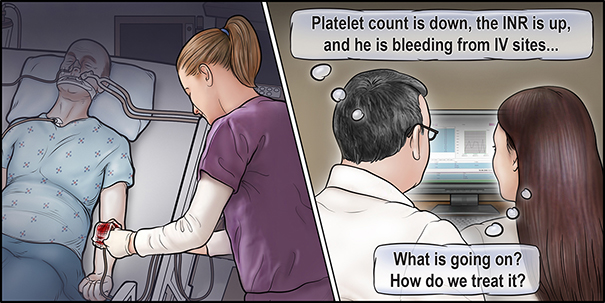The 7th installment of the NEJM’s critical care series presented us with an elderly man with sepsis who acutely coagulopathic and who has slight bleeding from his abdominal wound and from around his arterial and central venous catheters. His Hb is 89 and he is haemodynamically stable. How aggressively would you elect to manage this man’s coagulopathy?
Read more to find out how the the series editors reviewed the evidence on management of coagulopathy and DIC in the ICU.

A 77-year-old man is admitted to the ICU after a Hartmann’s procedure for fecal peritonitis. He is ventilated and in septic shock. His blood pressure is supported with fluid resuscitation and a norepinephrine infusion. In addition to intravenous antibiotics, his treatment included subcutaneous unfractionated heparin (5000 U twice daily).
The patient’s nurse notes slight bleeding from his abdominal wound and from around his arterial and central venous catheters.
Laboratory test results from that morning include normal LFTs, a Hb of 8.9 g per deciliter, a platelet count of 54,000 per cubic millimeter, an INR of 1.6, an APTT of 52 seconds, and a fibrinogen level of 1.7 g per liter.
We were asked at this point how agressively this mans coagulopathy should be managed.
45% of respondents elected to manage this man’s coagulopathy conservatively with cessation of S/C heparin and repeat laboratory tests in 8 to 12 hours. This was supported by the series editors in the absence of clinical features of significant bleeding. Interestingly, one third of the 4272 responses voted to also transfuse cryoprecipitate and fresh-frozen plasma or prothrombin complex concentrate.
The editors note that the cause of this patient’s bleeding disorder is unclear and could be multifactorial. Given that this man presents with sepsis, DIC should be considered with further specific blood tests. These results should be factored into a DIC scoring system such as that devised by the International Society on Thrombosis and Hemostasis which can be found on page 605 of this paper. Central to this diagnostic algorithm is that there be an underlying diagnosis known to be assocatiated with DIC.
Given that this man is receiving heparin, heparin-induced thrombocytopenia is clearly another possible diagnosis. However, unless the patient has been “previously been exposed to heparin, then HIT is very unlikely after only 1 day of exposure”. The authors note that the screening tests for HITs have a low specificity and should be followed by specific confirmatory tests if positive.
The case and the editors comments in full can be found here.
The accompanying review article by Beverley Hunt provides an excellent review of the pathophysiology of the various bleeding disorders encountered in the ICU and the (often limited) evidence regarding their management. It can be found here.

























